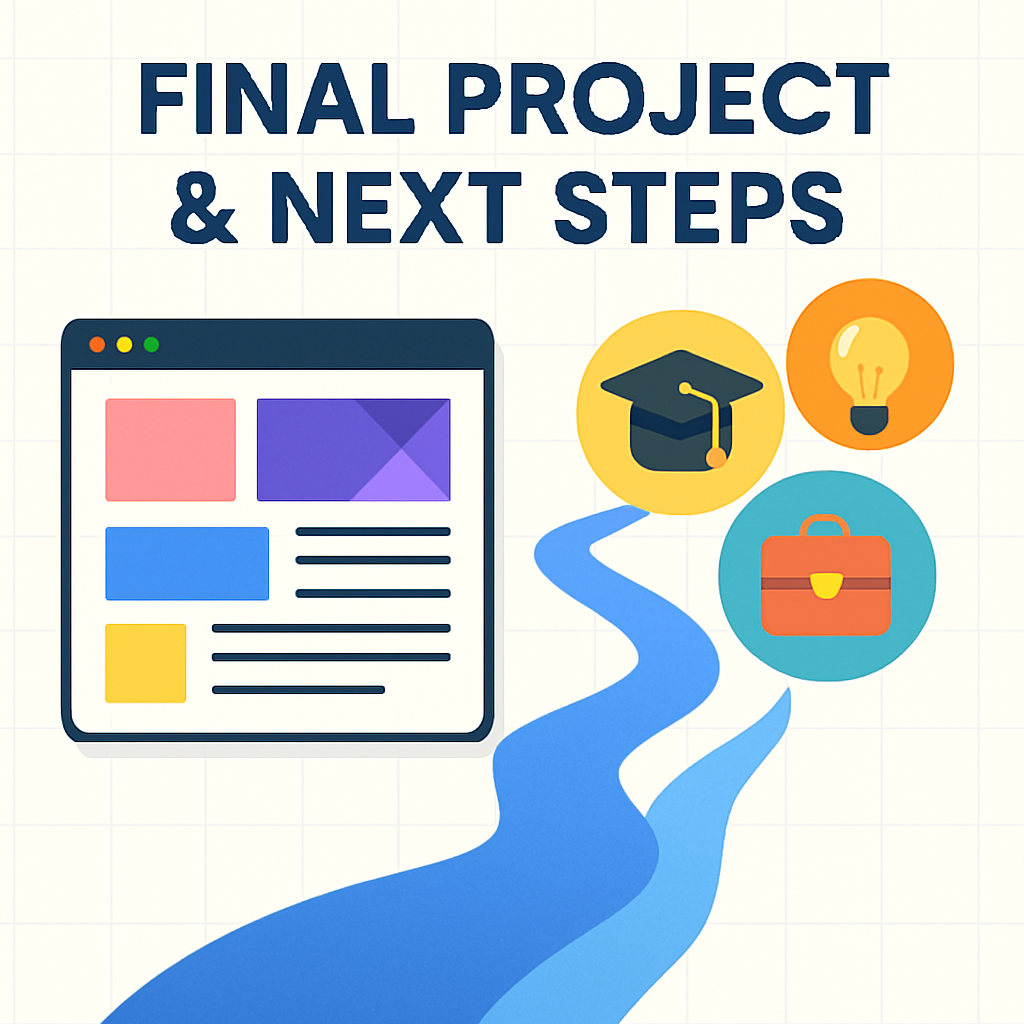Module 12: Final Project & Critique

Welcome to Module 12, the culmination of your journey through the fundamental principles of graphic design! Throughout this course, we have explored a wide array of concepts, from visual intelligence and hierarchy to the Golden Ratio, Hick's Law, Fitt's Law, the Rule of Thirds, Gestalt principles, the power of white space, the wisdom of Occam's Razor, and the enduring influence of Bauhaus design. Now, it is time to synthesize this knowledge and apply it to a practical design challenge. This final module will guide you through the process of conceptualizing, developing, and refining a design project of your own. We will also touch upon the crucial skills of self-critique and how to approach peer feedback, essential components for continuous growth as a designer. The goal is not just to create a finished piece, but to demonstrate your understanding of the principles we\ve covered and to reflect on your design process.
Applying Learned Principles to a Practical Design Challenge
The core of this module is a hands-on project where you will have the opportunity to apply the diverse range of design principles learned throughout this course. The objective is to select a design challenge that allows you to demonstrate your understanding of hierarchy, layout, typography, color, and the thoughtful application of specific principles like the Rule of Thirds, Gestalt theory, or even Bauhaus-inspired aesthetics, depending on your chosen project.
Here are a few suggested project ideas, but feel free to propose your own if it aligns with the learning objectives:
-
Social Media Campaign Graphics: Design a series of 3-5 visually cohesive graphics for a fictional (or real, with permission) brand or cause for a platform like Instagram or Facebook. Consider your target audience, the message, and how you will use hierarchy, color, typography, and imagery to create impact. Think about how grid systems (like F-Grid or Z-Grid for individual posts, or even a larger profile grid aesthetic) and principles like the Rule of Thirds could apply.
-
Simple Webpage Layout: Design the layout for a single webpage (e.g., a homepage for a personal portfolio, a landing page for an event, or a product feature page). Focus on clear navigation, visual hierarchy guiding the user to key information or calls-to-action, and the effective use of white space. Consider Fitt's Law for button placement and Hick's Law for menu simplicity.
-
Personal Logo and Branding Element: Develop a personal logo for yourself or a fictional entity. Apply principles of simplicity (Occam's Razor), perhaps explore geometric forms (Bauhaus influence), or consider proportions based on the Golden Ratio. Along with the logo, create one additional branding element, such as a simple business card layout or a social media profile icon, ensuring visual consistency.
Whichever project you choose, the process should involve initial brainstorming and sketching, developing digital drafts, and refining your work based on the principles discussed. Document your design choices and be prepared to explain how specific principles informed your decisions. For example, how did you establish visual hierarchy? What Gestalt principles are at play? How did you use white space to enhance readability or focus?
Guidance on Self-Critique and Peer Feedback
Becoming a proficient designer involves not only creating work but also critically evaluating it. Self-critique is a vital skill that allows you to identify strengths and weaknesses in your own designs and to iterate effectively.
Self-Critique Questions to Consider:
- Clarity: Is the message clear and easy to understand at a glance?
- Hierarchy: Is there a clear visual hierarchy guiding the viewer's eye to the most important elements?
- Balance and Composition: Does the layout feel balanced? How are elements arranged (e.g., Rule of Thirds, grid usage)?
- Typography: Is the typography legible, appropriate for the message, and well-spaced?
- Color: How does the color palette contribute to the message and overall aesthetic? Is there sufficient contrast?
- Functionality (if applicable): If it's an interactive design, is it easy to use? Are calls-to-action clear (Fitt's Law)?
- Alignment with Principles: How have specific design principles (Gestalt, Hick's Law, Occam's Razor, etc.) been applied or considered?
- Originality and Creativity: Does the design offer a fresh perspective or effectively solve the problem in an engaging way?
- Areas for Improvement: What are the weakest aspects of the design? What could be done differently to improve it?
Peer Feedback (if a community aspect were available): While this course is self-directed, in a collaborative environment, giving and receiving constructive feedback is invaluable. When giving feedback, focus on being specific, objective, and helpful. Refer to design principles. Instead of saying "I don\t like it," try "The hierarchy could be stronger if the headline had more contrast with the background." When receiving feedback, listen openly, ask clarifying questions, and remember that the goal is to improve your work, not to defend it. Not all feedback needs to be implemented, but all of it should be considered.
Showcase of Example Projects (Conceptual)
To provide inspiration, imagine a showcase of successful final projects. One student might present a series of vibrant, geometrically structured social media posts for a music festival, clearly applying Bauhaus principles and a strong visual hierarchy. Another might showcase a clean, minimalist webpage layout for a sustainable products company, demonstrating excellent use of white space and adherence to Hick's Law in its navigation. A third could present a clever logo design that utilizes Gestalt principles of closure and figure-ground, along with a beautifully proportioned business card based on the Golden Ratio.
These examples would highlight not just the aesthetic outcome but also the thoughtful application of the design principles learned throughout this course. Your final project is your opportunity to demonstrate your understanding and to create a piece that reflects your growing skills as a designer. Focus on the process, apply the principles diligently, and most importantly, enjoy the creative challenge!